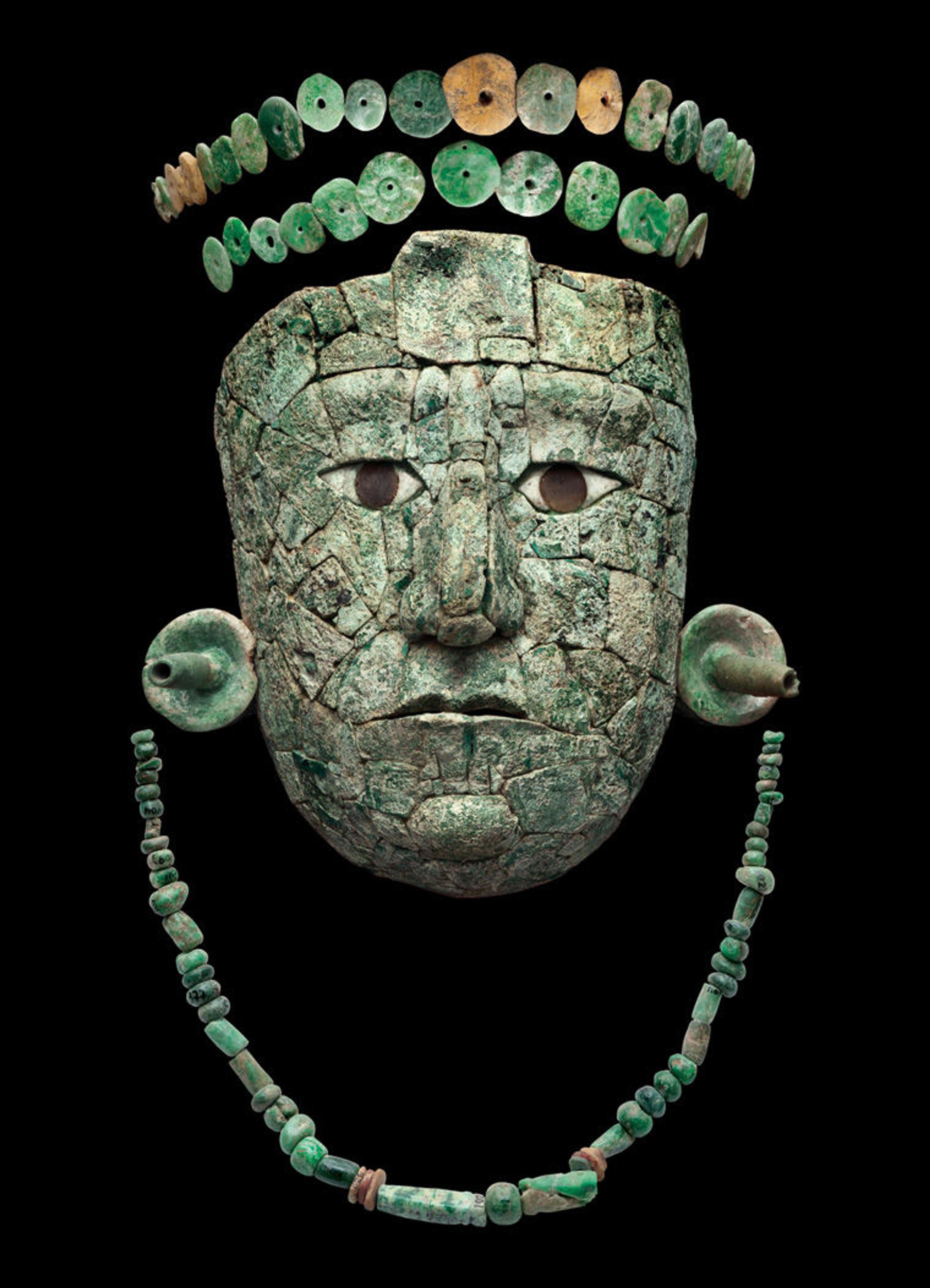
Mask of the Red Queen, A.D. 672. Mexico, Chiapas, Palenque, Temple XIII. Maya. Jadeite, malachite, shell, obsidian, limestone, H. 14 7/16 x W. 9 1/16 x D. 3 1/8 in. (36.7 x 23 x 8 cm). Museo de Sitio de Palenque "Alberto Ruz L'Huillier" (10-461006, 10-629739 0/39, 10-629740 5/55), Secretaría de Cultura—INAH
«Among the many recently discovered works presented in the exhibition Golden Kingdoms: Luxury and Legacy in the Ancient Americas are the spectacular ornaments and funerary objects that reveal the newly understood prominence of women of power in the ancient Americas. Had we organized this exhibition twenty-five years ago, we would have spoken primarily of the regalia of men. Over the course of a single generation, thrilling discoveries have revealed the power and majesty of high-status women, deepening and enriching our understanding of ancient American history.»
The Maya site of Palenque (ancient Lakamha'), located in the foothills of the Chiapas highlands with a commanding view of the Tabasco Plain, was home to a powerful dynasty in the seventh century A.D. Great patrons of the arts, K'inich Janaab Pakal I and his family oversaw the creation of what has become acknowledged to be one of the most innovative and beautiful of all Maya sites. The discovery of Pakal's tomb within the Temple of the Inscriptions was made in the middle of the twentieth century, but the tomb of his spouse, Lady Tz'akbu Ajaw, only to came to light in 1994, through the work of Arnoldo González Cruz and colleagues.
Lady Tz'akbu Ajaw's funerary monument, now known as Temple XIII, contained her limestone sarcophagus, the interior of which was painted with crimson cinnabar. Following her interment in the sarcophagus, her body and accompanying ornaments and offerings were also covered with a thick layer of cinnabar. Understandably dubbed the Red Queen, her burial is one of the richest known for a female Maya ruler. In addition to a headdress of greenstone and shell and an elaborate collar of multicolored stone and shell beads, she wore a headband composed of two rows of circular disks made of the type of fine apple-green jade most prized by the Maya. The mask over her face, made of malachite tesserae, has limestone and obsidian eyes that appear to bore right into you, conveying a striking sense of the presence of the queen.
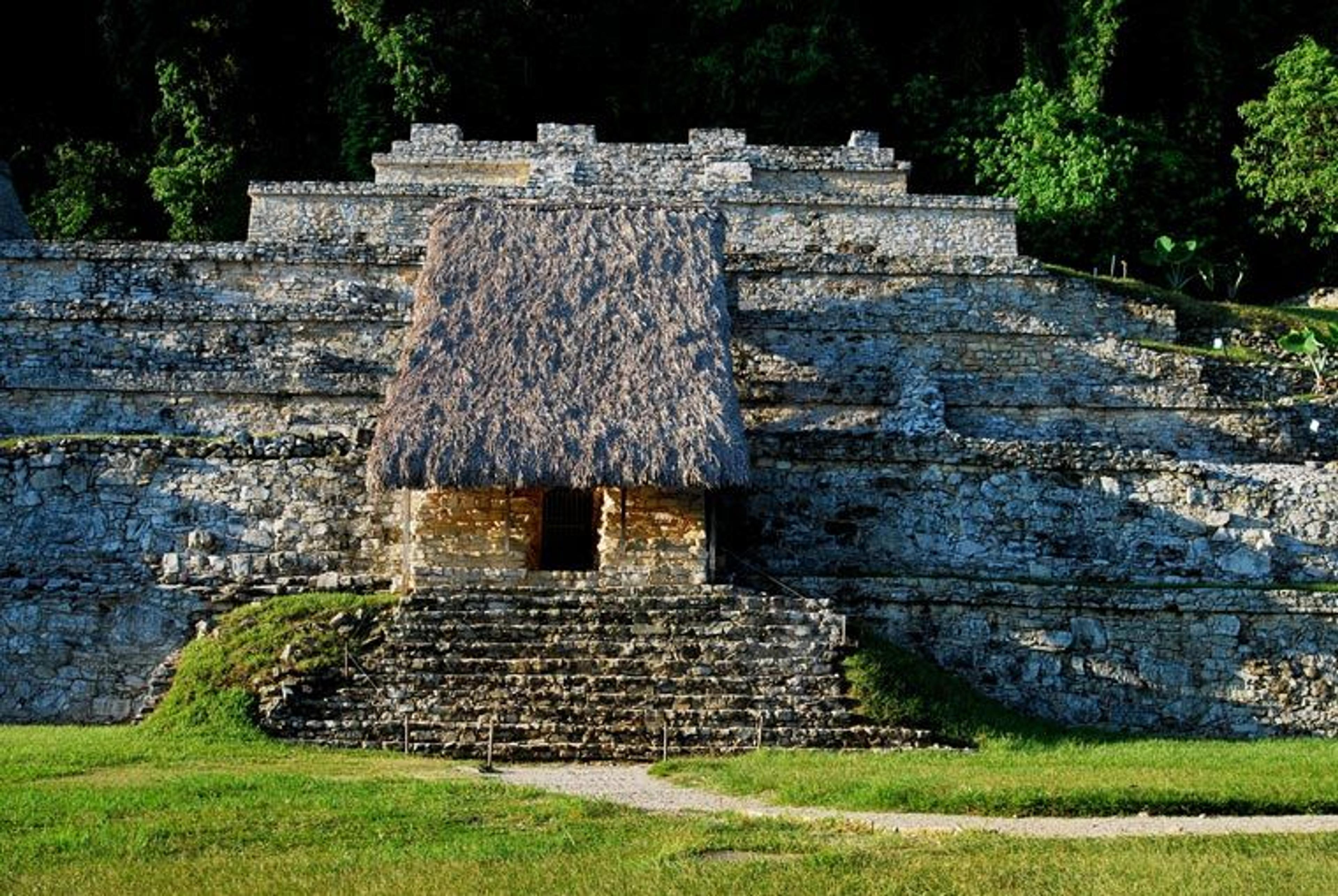
View of Temple XIII, Palenque, Chiapas, Mexico. Photo by Héctor Montaño. © Secretaría de Cultura—INAH
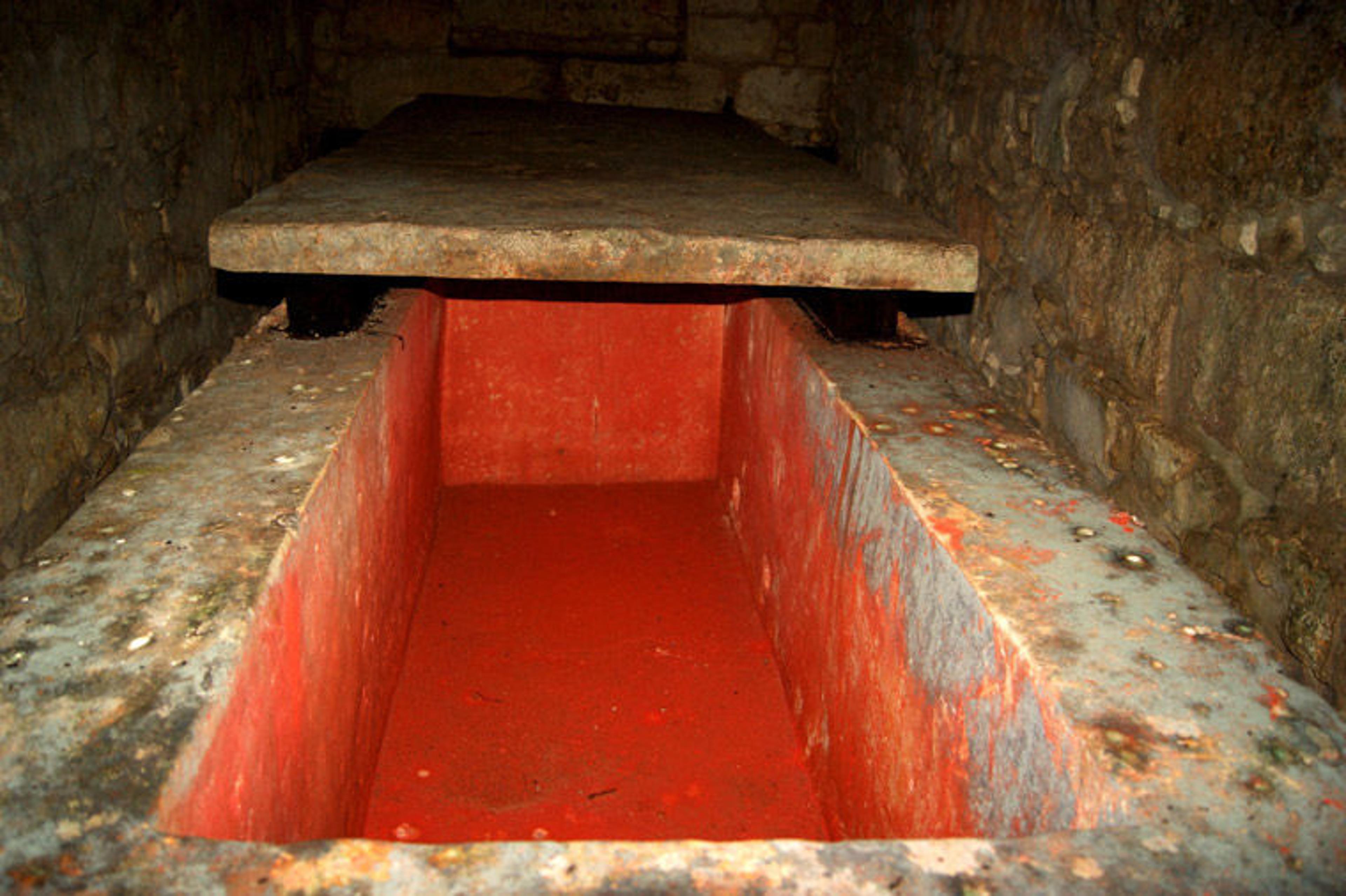
The sarcophagus of the Red Queen, Palenque. Photo by Héctor Montaño. © Secretaría de Cultura—INAH
Left: Stela with Queen Ix Mutal Ahaw, A.D. 761. Mexico or Guatemala. Maya. Limestone, H. 92 x W. 45 x D. 3 in. (233.7 x 114.3 x 7.6 cm). Fine Arts Museums of San Francisco, Gift of Mrs. Paul L. Wattis (1999.42)
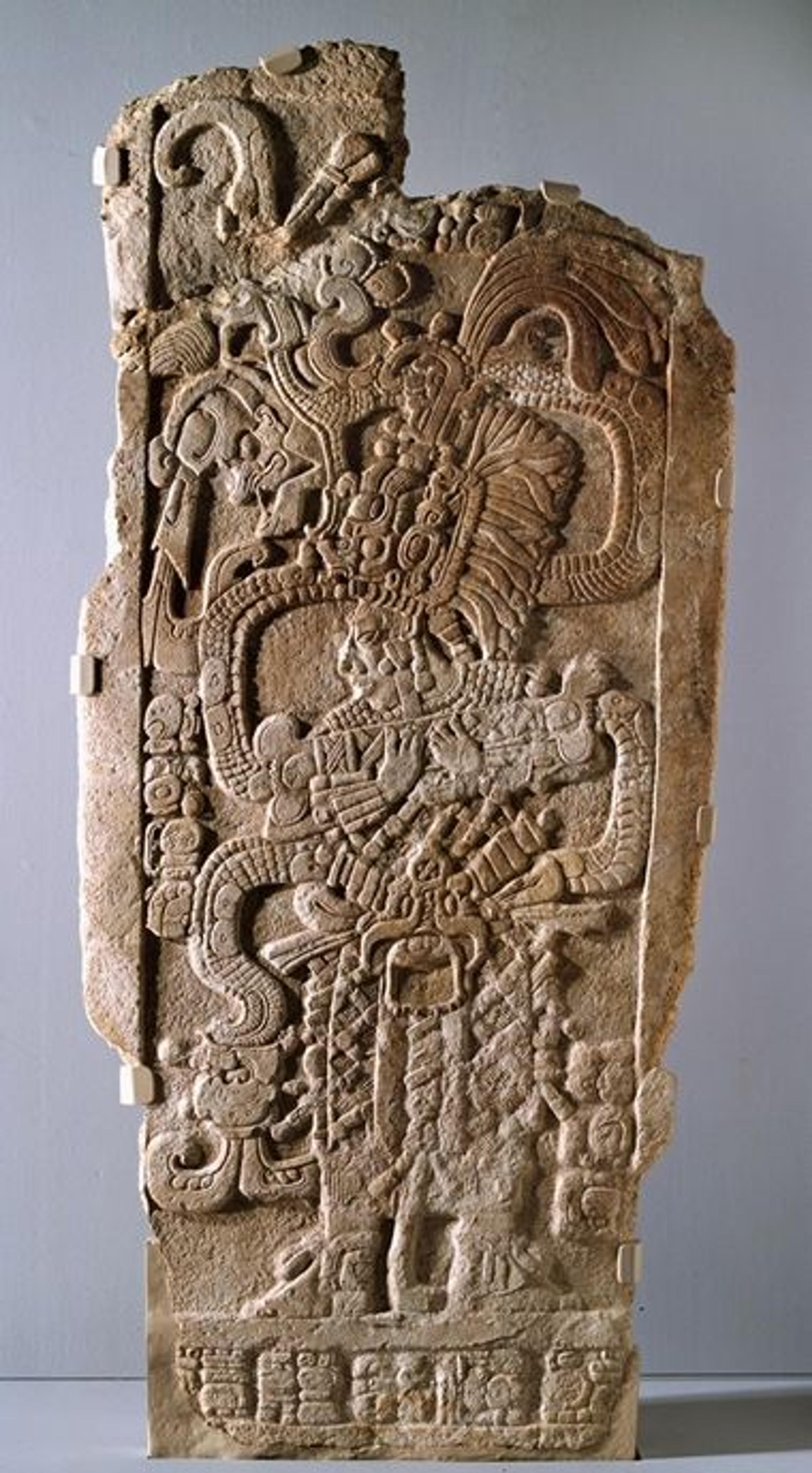
Almost a century after the burial of the Red Queen, a stela depicting a woman known as Ix Mutal Ahaw, or "royal lady of Mutal," was erected at an unknown site in the Usumacinta River region. Mutal is the place name of the great city of Tikal, although it might also refer to a related lineage based at Dos Pilas. (Both sites are in in what is now Guatemala.) The queen holds a femur-shaped ceremonial bar from which a supernatural serpent emerges and then swirls behind her. Women in Maya culture were key players in conjuring deities, and among the most striking works of Classic Maya relief sculpture show royal women engaging with supernatural powers (such as the Yaxchilan Lintels 24 and 25, now at the British Museum).
In this stela a version of the Maya god of lightning, K'awiil, appears from the mouth of the serpent, further extending the queen's ability to contact and engage the powers of other worlds. This relief was once painted with bright colors to underscore her elaborate regalia—including the resplendent quetzal feathers of her headdress, the jade ornaments that adorned her garments, and the Spondylus shell at her waist.
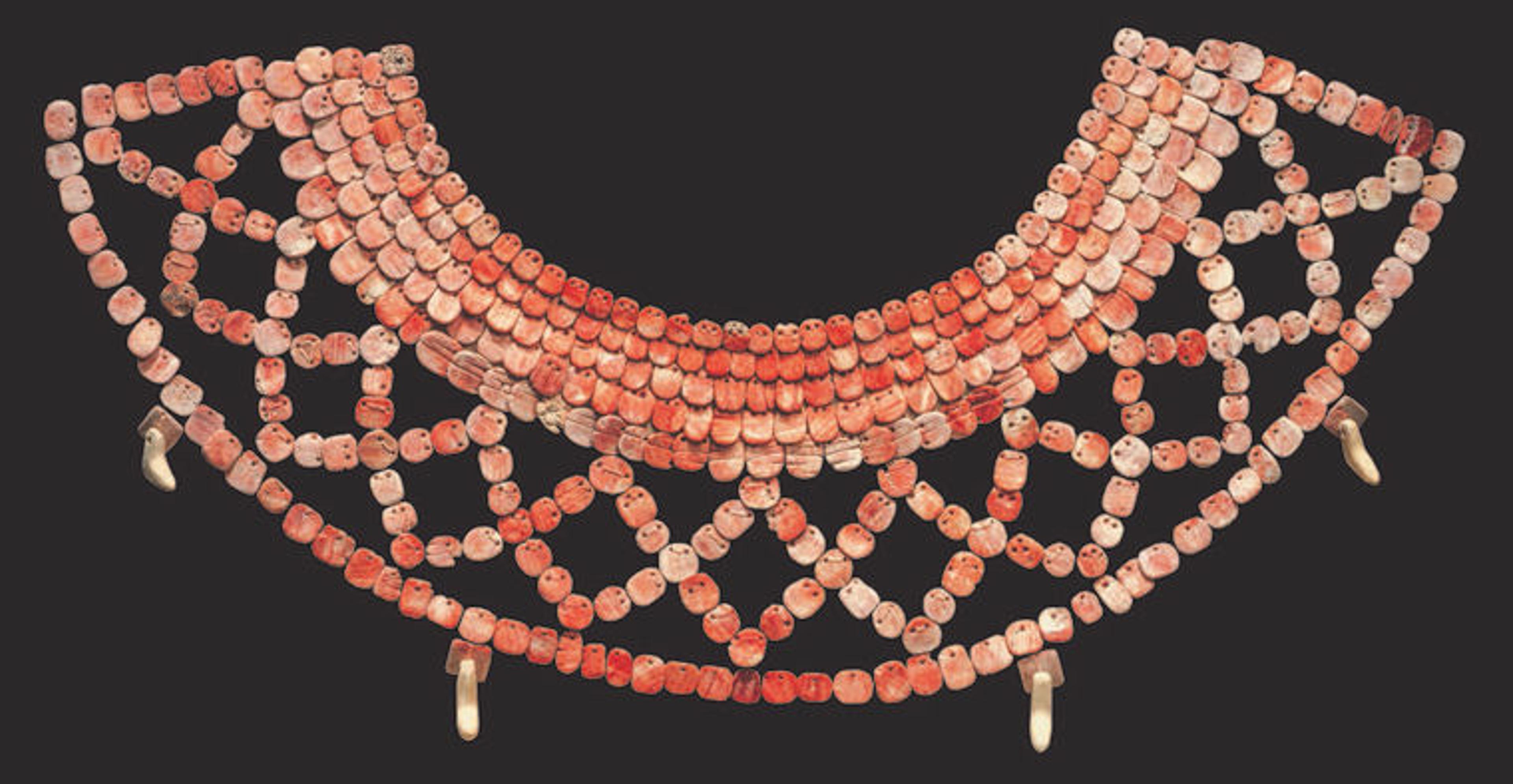
Collar, A.D. 600–660. Mexico, Campeche. Maya. Shell (Spondylus princeps), H. 12 5/8 x W. 26 x D. 3/4 in. (32.1 x 66 x 1.9 cm). Museo Arqueológico de Campeche, Fuerte de San Miguel, Secretaría de Cultura—INAH (10-629922 0/383)
Spondylus—a shell that would have been of considerable complexity to acquire—was often closely associated with women in the ancient Americas. We know of its use in an array of ritual events, and it was closely tied with fertility, always a critical basis of elite power. A remarkable collar made of 380 circular disks cut from the characteristic red cortex of Spondylus princeps was one of the rich offerings that accompanied the burial of a royal woman at Calakmul, Campeche, Mexico.
Thanks to recent excavations at El Perú-Waka', a site in the Petén region of northern Guatemala, we know that royal women even wore what are considered the crown jewels of the Classic Maya, a type of headdress ornament (hu'unal) that would have been worn perpendicular to the forehead. This particular hu'unal ornament was one of some 2,400 shell and greenstone objects in the tomb of a royal woman, possibly Lady Pakal of Calakmul, who married into the local royal court of El Perú-Waka'. Made of rare, brightly colored, imported materials painstakingly worked into elegant forms, these ornaments speak to these dynasties' control over resources—from the acquisition of rare, imported materials, to the ability to marshal the finest artists to create such regalia.
Right: Hu'unal headdress ornament, A.D. 700–800. Guatemala, Petén. Maya. Jadeite, H. 4 5/16 x W. 2 5/16 x D. 3/16 in. (11 x 5.9 x 0.5 cm). Museo Nacional de Arqueología y Etnología, Guatemala City (17.7.64.244)
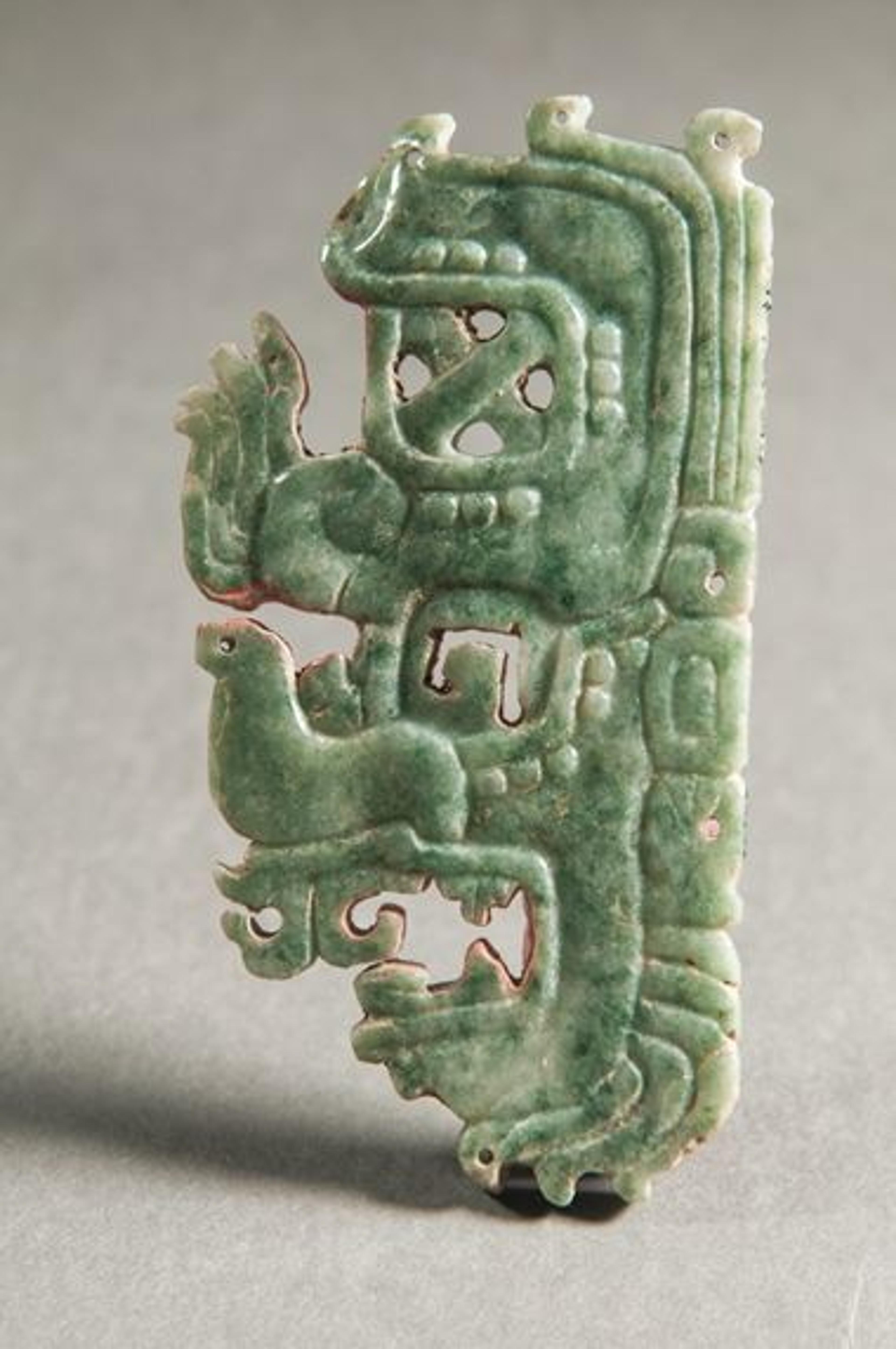
For years scholars assumed that queens featured on relief sculpture, mural painting, and painted ceramics were peripheral to the primary currents of political power, which had been wielded by men. Yet in recent years, scholars such as Traci Ardren, Michelle Rich, Kathryn Reese-Taylor, Renata Schneider, and others have revealed the complexity and power of Maya queens not only in ritual practice but also in rulership. Aided by the study of hieroglyphic texts and a close study of the depictions of dress and identity, scholars are now piecing together the histories of these women and the role they played in ancient Mesoamerica.
For the Andean region, the discovery of the tombs of high-status females is very new, and it is inverting our understanding of both political authority and ritual practice. In the Andes we do not have the benefit of texts, so the role of these powerful women is more ambiguous: Was the woman interred at Chornancap, in the Lambayeque region of Peru's north coast, a high priestess or a queen, or both? What does it mean that the Lady of Cao was interred with war clubs and spear-throwers—weapons usually associated with men—along with her forty-four (yes, forty-four!) nose ornaments, a type of object generally worn by men?
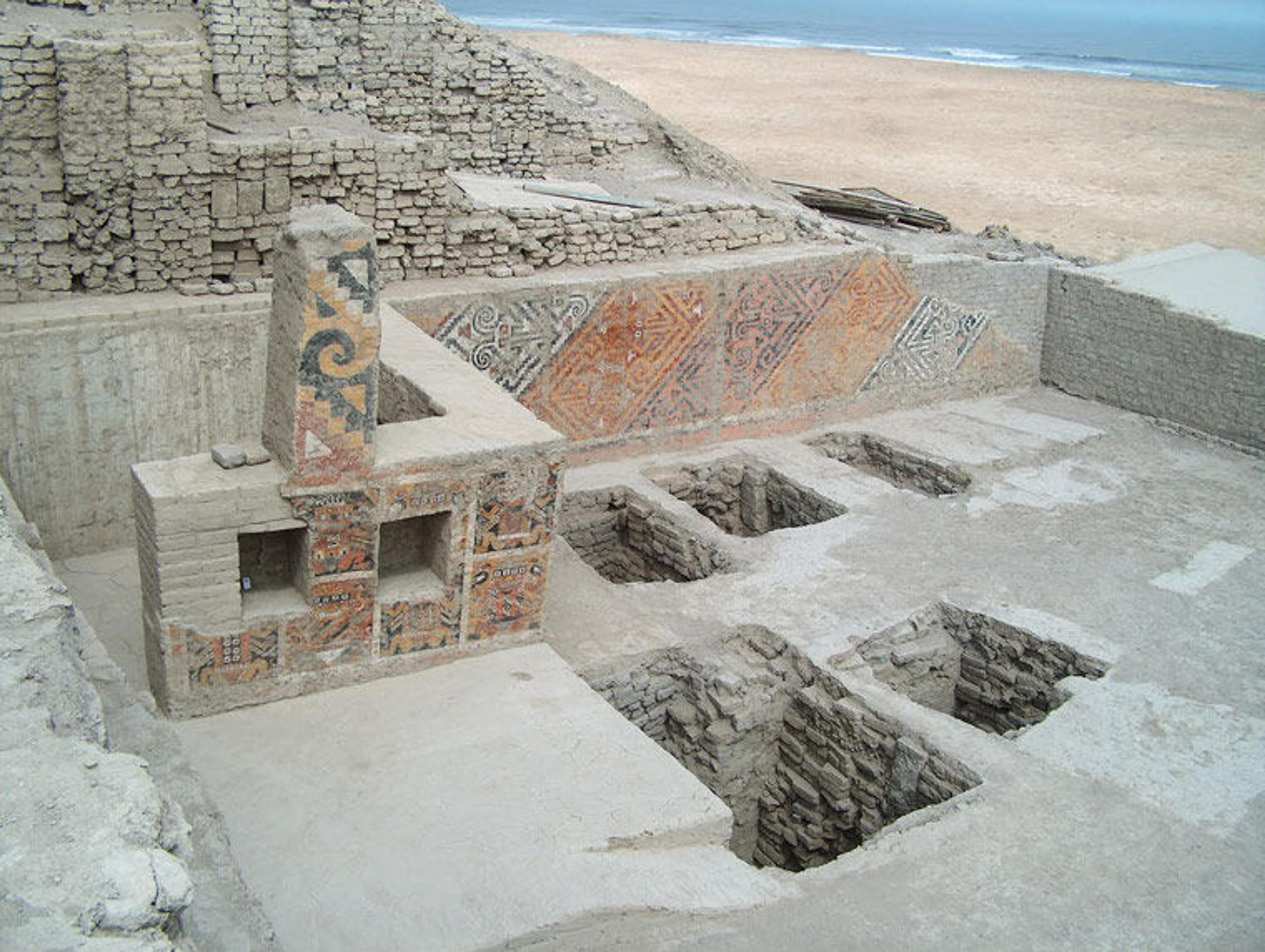
View of Huaca Cao Viejo with the tombs of the Lady of Cao and her companions at the El Brujo Archaeological Complex near Trujillo, in northern Peru. Photo courtesy of Fundación Augusto N. Wiese
Around 400 A.D. a powerful young woman reigned from a spectacular monumental center at the edge of the Pacific Ocean in Peru's Chicama Valley. Named after the site where she was found, the Lady of Cao was laid to rest near the top of a brightly painted monumental pyramid-platform. In 2004, archaeologist Régulo Franco and colleagues carefully unwrapped the twenty-six layers of her funerary bundle, revealing exquisite textiles, weaving tools, deftly detailed ornaments, and ceremonial weapons normally associated with men. All of these items indicate her high status and position of power.
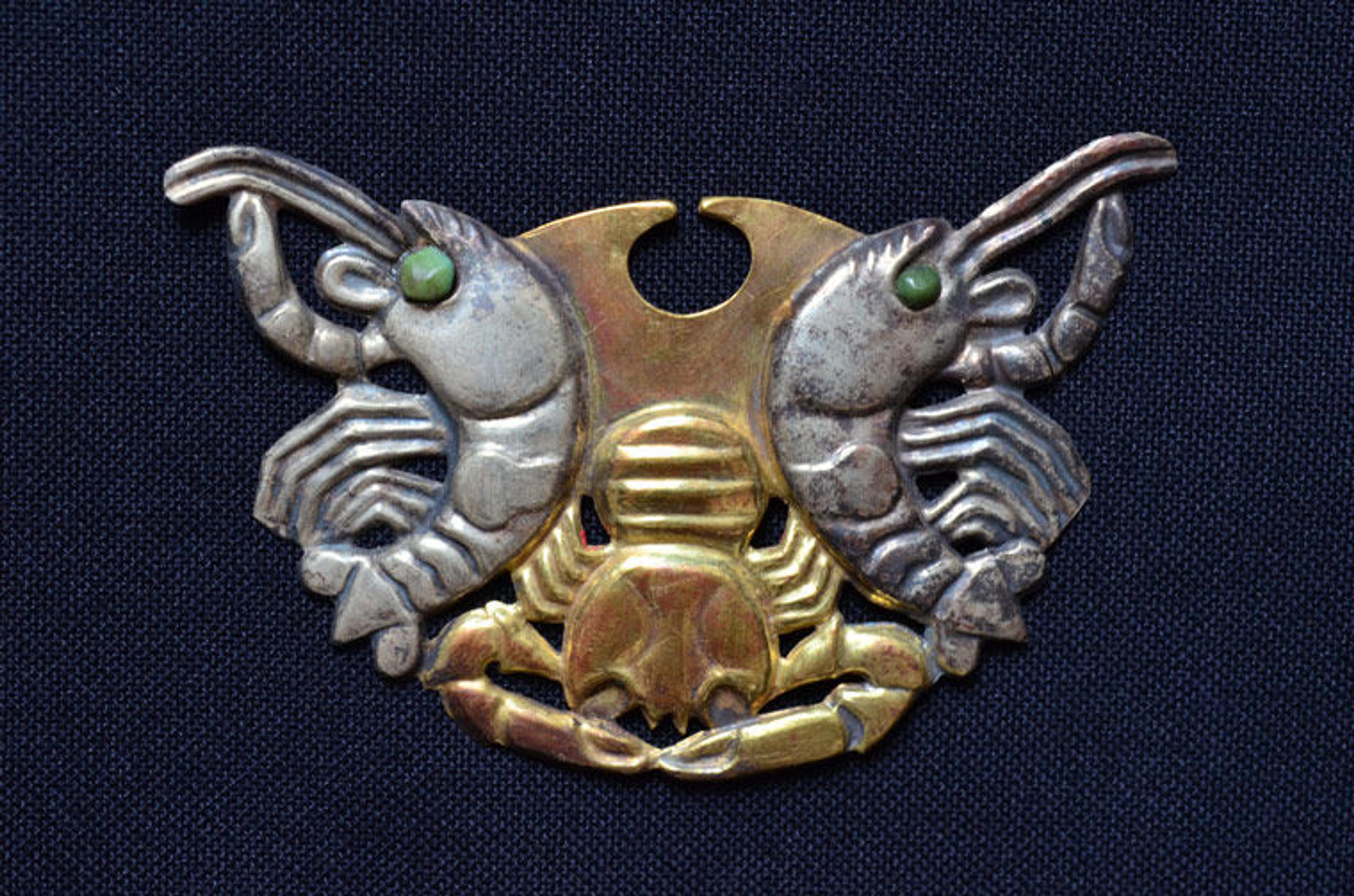
Nose ornament, ca. A.D. 400. Peru, El Brujo, Huaca Cao Viejo, Tomb of the Lady of Cao. Moche. Gold, silver, turquoise inlays, H. 1 15/16 in. (5 cm). Museo Cao, Magdalena de Cao, Peru (PACEB-F4-00015), Ministerio de Cultura del Perú. Photo courtesy of Fundación Augusto N. Wiese
Among these splendors were the delicately rendered nose ornaments, each decorated with a unique design of geometric and zoomorphic motifs in bilateral symmetry. Made of gold and silver sheet metal carefully joined together, the nose ornament above features a pair of crayfish laying back-to-back, adjoined by a downward-facing crab cleverly placed at the center of the elegant composition. Turquoise inlays mark the crustaceans' eyes, providing further dimensionality and detail to the ornament.
Left: Scepter, A.D. 900–1300. Peru, Chornancap, Tomb of the Priestess (Tomb 4). Lambayeque. Gold, H. 9 3/8 x W. 2 1/2 in. (23.8 x 6.4 cm). Museo Arqueológico Nacional Brüning, Lambayeque (CH-00001), Ministerio de Cultura del Perú
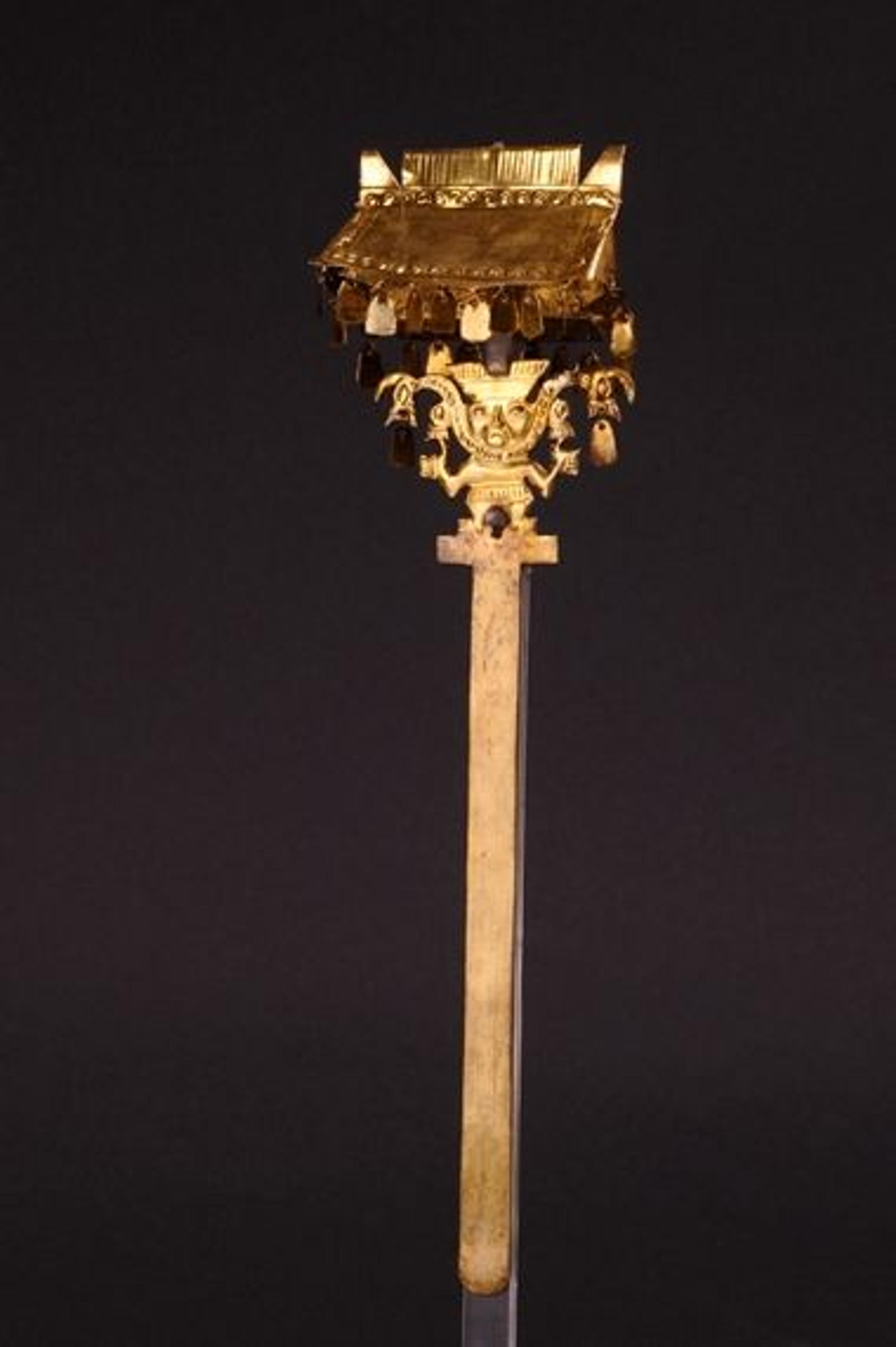
The most recent woman of power to come to light in recent years is an individual now known as the Priestess of Chornancap. In 2011, archaeologist Carlos Wester La Torre and colleagues excavated her tomb at what is believed to be one of the most important political and religious centers on Peru's north coast from the tenth through fourteenth centuries A.D. This scepter, made of gold sheet, was found near her left hand along with other ornaments and funerary goods. At the top of the scepter, a figure wearing a trapezoidal headdress stands within a temple structure. Such scepters with temple motifs are rooted in a long-standing tradition on Peru's north coast, and the architectural effigies depicted within them likely symbolized an individual's political and religious power.
In the sixteenth century, some of the first Spaniards to arrive on Peru's north coast described—with some apparent surprise—that women and men ruled equally. These recent archaeological discoveries provide us with a new view of gender and political complexity in the ancient Americas. Many questions remain, but the exquisite regalia of these powerful women help bring to the fore a new understanding of the fifty percent of the population that was for centuries seldom seen.
Related Content
Golden Kingdoms: Luxury and Legacy in the Ancient Americas, on view at The Met Fifth Avenue through May 28, 2018
See more digital content related to Golden Kingdoms, including a walkthrough of the recent exhibition in English and in Spanish.
Read more articles in this exhibition's blog series.
Purchase a copy of the exhibition catalogue in The Met Store.